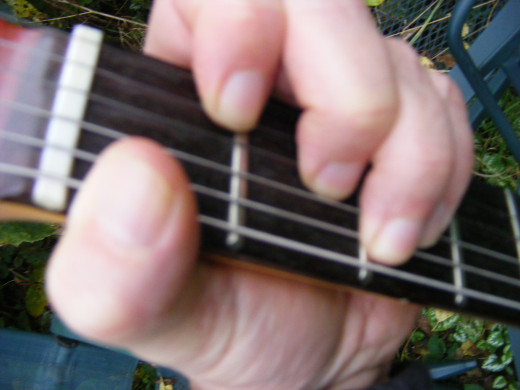Guitar Chords, Barre Chords
Guitar Chords - Barre shapes
If you need some help with basic music theory on guitar, try my other hub
Guitar Chords - Theory Tips.
For many people, playing barre shapes is a difficult stage in their guitar-playing experience.
This hub looks at ways to avoid some of the problems. It will work fine on electric or steel string guitars of every description, but not so well on nylon- string or classical necks, due to the width of the neck. As it will decrease the effort expended by using standard barre shapes, you should find that you can play for longer periods.
- When learning barre shapes, don't start with an F chord in fret 1, even though this is the first chord in these pictures. As the fret distances are greater in the lower frets, it should be easier to form barre shapes further up the neck, where the frets are closer together.
- Fret 5 ( A major) would be a good place to start.
- The chord grids show a standard barre (loop symbol means flatten the first finger across all the strings) with the 6 vertical lines representing the 6 strings.
- Further down the page are some photos demonstrating the shapes.
Standard barre chords - some tips
- If you haven't been playing long, maybe less than one year, part of the problem with playing barre shapes is probably a lack of finger strength
- Try to get your thumb pointing towards the headstock behind the neck, as shown in the photos below. Your hand is braced away from the neck.
- Instead of having your first finger dead flat on the fingerboard, try tilting it slightly, back towards the headstock. This way more of the bone can be used to make a clean barre shape
- Just buy a better guitar!
Barre chords in C, then E

Barre chords and replacements

Thumb round the neck version
Before you reach for the painkillers, try the thumb round the neck version (T = Thumb) This will give you the sound of the barre chord without so much effort, and probably clearer too, with less buzz.
Even better, try the three-finger and thumb version on the bottom line of chords. The thumb projects a little, and mutes string 5, which we don't want to hear. This shape is a breeze to slide up and down the neck for quick chord changes. String 1 is also muted, which happens anyway if you have your first finger in the right place.
- This shape is a root 6 chord, that is, the root note is on string 6
- If you're playing the full standard barre version, the root is also on string 1
- String 1 and string 6 are tuned the same (E)
Minor barre chords
Looking at the second chord grid - if you move the note on string 3 down one fret, you get a good root 6 minor chord shape ( this shape is shown below, as Fm) Now you have a partial barre shape on strings 1-3, with your thumb on string 6 as before.
Chord pictures show a standard barre (root is string 5) and a thumb round the neck replacement. String 6 should not be sounded, and is muted by your thumb anyway. This chord shape is not for everyone, as it may be a bit difficult unless you are well versed in using your thumb like this.
More barre chord alternatives
Next chord grids show a useful sus 4 chord, and my favourite minor chord shape. You can nearly always replace a minor chord with a minor 7th chord (m7) and it will sound better 90% of the time.
Once this shape is in place, it's quite easy to add a 9th note, making a minor 9 (m9) shape.
Here the chords shown are Gm7 and Gm9, Just move the shape up 2 frets and you have Am7 and Am9.
Standard Barre Shape

Barre shape using thumb

Barre shape using thumb, easy version

Hendrix chord shapes

Hendrix chord shapes
Jimi Hendrix remains one of the all-time guitar greats, and part of the reason for that is his use of great chords and rhythm guitar parts.
The first 4 chord grids show a secondary guitar part used on All Along The Watchtower, and the last line shows a couple of the chords used in Little Wing.
- These add9 chords are based on the chord forms that we've just been discovering. Only one new note is added, on string 1, but it gives a much brighter and more interesting sound than a plain or vanilla major chord.
- The chords for Little Wing have an open G string ringing too - try sliding from one chord to the next.
- The last chord shape is one of my favourites, and can be used at other places on the neck. Try moving it up the neck to start in fret 4 and also fret 9. Here it is a substitute chord for an F sharp minor chord, and you can resolve the chord to an E.
- Note that this is a thumb over the neck shape, and strings 1 and 2 are open, which creates great ring and sustain. Another of my hubs covers open string chords - this is one of many effective voicings.
More info on barre chord shapes, chord names etc is on my other hub, Guitar Barre Chords and how to avoid them.
One final strategy
OK - so you're trying the standard barre shape shown in the first photo, and it's not working yet because of string buzz or lack of strength in your first finger.
- Just arch your first finger, so it's only covering string 6, the thickest string.
- Don't barre the whole shape, you can do this later as your hand gets stronger, using the daily practice routine of 10 -15 mins that I'm sure you are already doing!
- Now just play strings 6, 5, 4, 3
- This is really all you need for a full sounding chord
- If you use this shape at frets 5 and 7 ( A and B) and play the open strings 1 and 2, you will get some of the best sounding chords on the guitar, open chords. My other hubs have more detail on these chord shapes.
- Soon you should find it easy to collapse your first finger for a full barre shape.








